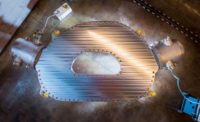A nuclear fusion startup led by scientists at MIT to create a revolutionary fusion nuclear reactor that would imitate the way the sun generates energy is getting ready to go on a hiring spree.
Commonwealth Fusion Systems, founded in 2018 by MIT scientists, will soon begin its search for construction and engineering firms to help build SPARC, an experimental machine that would create the first human-made, self-sustaining fusion reaction using hydrogen isotopes.
The machine, a mini-reactor, will allow researchers to study the physics of fusion reaction, also referred to a burning plasma, which has been likened bringing a mini-sun to Earth. If successful, a full scale plant could be built.
Construction slated for June, 2021
The construction start, tentatively next June, comes on the heels of the publication of seven peer-reviewed papers in the Journal of Plasma Physics laying out the science behind the new fusion system, which has been well received in the academic community.
“It was an important milestone to get that vote of confidence,” Martin Greenwald, deputy director of MIT’s Plasma Science and Fusion Center and one of the project’s lead scientists, said of the publication.
A spokesperson for Commonwealth Fusion said the startup isn’t ready to discuss in details its plans to hire outside contractors.
However, Commonwealth plans to bring on board “a range of engineering firms, construction firms, and other consultants/contractors” for the construction process, wrote Kristen Cullen, a spokesperson for the firm, in an email.
The Cambridge, Mass.-based company, which employs 100 in addition to working with 70 to 80 researchers at MIT, is also in the midst of hiring internally for an array of engineering jobs.
Commonwealth, which has raised $200 million from investors, is also on the hunt for a new location on which to build the SPARC machine, its headquarters and manufacturing facility.
With dozens of acres needed, the company decided remaining in densely packed Cambridge, where research and commercial space comes at a premium, was not an option.
Instead, Commonwealth has been looking at locations across the Northeast and is now “finalizing our siting search,” Cullen said.
MIT Advances Set the Stage
Major engineering advances at MIT are underpinning all this activity.
One of the biggest hurdles has been how to control the burning plasma created by nuclear fusion, which, at tens of millions of degrees, can destroy any barrier or material in its path. The breakthrough has been the development of superconducting magnets that can generate significantly greater force to keep the superheated plasma contained and away from the walls of the SPARC reactor.
The use of magnets is not new. However, the ability to build more powerful superconducting magnets means any experimental machine—and ultimately power-generating reactor—can be much smaller and more compact than previously possible, MIT’s Greenwald said.
MIT researchers “realized the emergence of high-temperature superconducting technology enables a high magnetic field approach to producing net energy gain from a magnetic confinement system,” noted Chris Hegna, a professor of engineering physics at the University of Wisconsin at Madison, in a story published by the MIT News Office. “This work is a potential game-changer for the international fusion program."
That ability to go small, in turn, may give Commonwealth Fusion’s SPARC a significant advantage over one of its main rivals.
For example, the main rival to the Commonwealth Fusion’s SPARC project is the $22 billion ITER project in Southern France, which is designed to be the size of a hockey stadium.
By comparison, SPARC would be about the size of a high school basketball court, while its price-tag, at roughly $500 million, would be a fraction of ITER’s.
“We already know the basic laws of physics, how to run a fusion reactor,” said Ranganathan Gopalakrishnan, a mechanical engineering professor at the University of Memphis who is involved in his own research project around the use of nuclear fusion to generate power. “It is an engineering breakthrough,” Gopalakrishnan said. “I think it is more realistic in comparison with ITER.”






Post a comment to this article
Report Abusive Comment